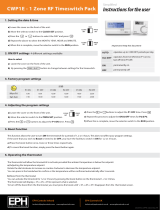
Operating Instructions
Page 1 of 2
RFC - RF Cylinder Thermostat
CAUTION!
Only qualied electricians or authorised
service sta are permitted to open the
thermostat.
Ensure that this wireless enabled
thermostat is installed 1 metre from any
metalic object, television, radio or wireless
internet transmitter.
20221019_RFC-Renesas(PR092K7)_OpIns_PK
EPH Controls Ireland
technical@ephcontrols.com www.ephcontrols.com
EPH Controls UK
technical@ephcontrols.com www.ephcontrols.co.uk
4. Installation
1. Factory default settings
6. Resetting the thermostat
7. Boost function
8. Lock function
2. Specications & wiring
Temperature indicator: °C
Switching dierential: 5°C
In built frost protection: 5°C
Keypad lock: O
Code button
Reset button
3a Mounting of temperature sensor
3b Mounting of thermostat
Contents
1. Factory default settings
2. Specication & wiring
3. Mounting
4. Installation
5. Button / symbol description
6. Resetting the thermostat
7. Boost function
8. Lock function
9. To connect the RFC thermostat to the
R_7-RF programmer
10. To disconnect the RFC thermostat from
the R_7-RF programmer
Prior to setting the thermostat, it is neccessary to complete all required settings described
in this section.
5. Button / symbol description
Important: Keep this document
Power Supply: 2 x AAA Alkaline Battery
Power consumption: 50 uA
Battery replacement: Once per year
Temp. Control Range: 10...90°C
Dimensions: 84 * 84 * 30mm
Temp. sensor: NTC 10K Ohm @ 25°C - 1.5m probe type
Temp. indication: °C
The thermostat should be mounted in a position that will make reading
the display conventient.
The thermostat can be tted to: 1. Recessed conduit boxes
2. Surface mounting boxes
3. Directly on walls
Press the button on the bottom of the thermostat.
The front housing will detach from the baseplate.
Insert the batteries (provided) into the thermostat.
Mount the unit as described in section 3. Ensure the cable sensor is
connected to terminals Con 3 and Con 4.
Oer the baseplate up to the thermostat. Snap it into position to close.
Press the boost button once, twice or three times to boost the heating for
1, 2 or 3 hours respectively. +1H, +2H or +3H will appear on the screen.
The boost function will override the programmer if the programmer is
timed to be O.
To lock the thermostat, press the hand wheel for 10 seconds. The keypad
symbol will appear on the screen.
To unlock the thermostat, press the hand wheel for 10 seconds. The
keypad symbol will disappear from the screen.
Press the button on the bottom of the thermostat, the front housing
will detach from the baseplate.
Insert the batteries into the thermostat.
Press the reset button on the PCB, ‘NO’ will ash on the screen.
Rotate the hand wheel clockwise until ‘YES’ appears on the screen.
Press the hand wheel once to conrm the setting.
The thermostat has now been reset and the current temperature will
appear on the screen.
Heating ON symbol
Water temperature Battery low symbol
Set point handwheel
Wireless symbol
Boost button
ON CYLINDER: To ensure accurate control of your cylinder, the temperature
sensor should be mounted on the bottom 1/3 of the cylinder. It is essential that
the sensing element is in direct contact with the cylinder and that there is no
insulation between it and the cylinder. 60°C is the temperature level required in
order to prevent the build up of legionella bacteria. The temperature sensor can
be xed to the cylinder using the provided foil tape.
ON PIPEWORK: To ensure accurate control, the temperature sensor should be
mounted on the pipework as tightly as possible. It is essential that the sensing
element is in direct contact with the pipework and that there is no insulation
between it and the pipework. The temperature sensor can be xed to the
pipework using the provided foil tape.






